
A. Lange & Söhne Triple Split
In-depth look – March 2020
In watchmaking, there are not many complications or technical advancements where one manufacture enjoys the monopoly. It is not 1931 anymore when Rolex patented the self-winding movement and others had to wait for years. Today, even though many brands have patents over different mechanisms, there are way arounds. Within A. Lange & Söhne context we can think of stop-tourbillon of Cabaret Tourbillon which Glashütte Original and Moritz Grossmanncame up with their own solutions a few years after. Of course, some enjoys superiority over others simply because they do it better, as Patek Philippe does with its minute repeaters. Yet, there are some that simply cannot be mimicked, or not even tried. One of them is here: Lange Triple Split. It is a watch that is based on an invention, where none other than the inventor tried or succeeded to surpass.
You’d know the famous motivational quotes revolving around the only competition that matters is the one takes place within yourself… Apparently, A. Lange & Söhne took this extremely seriously. They upped the ante where they were the only players just to stay true to their identity, to Never Stand Still. In 2018, this persistance brought the most complicated chronograph ever made.
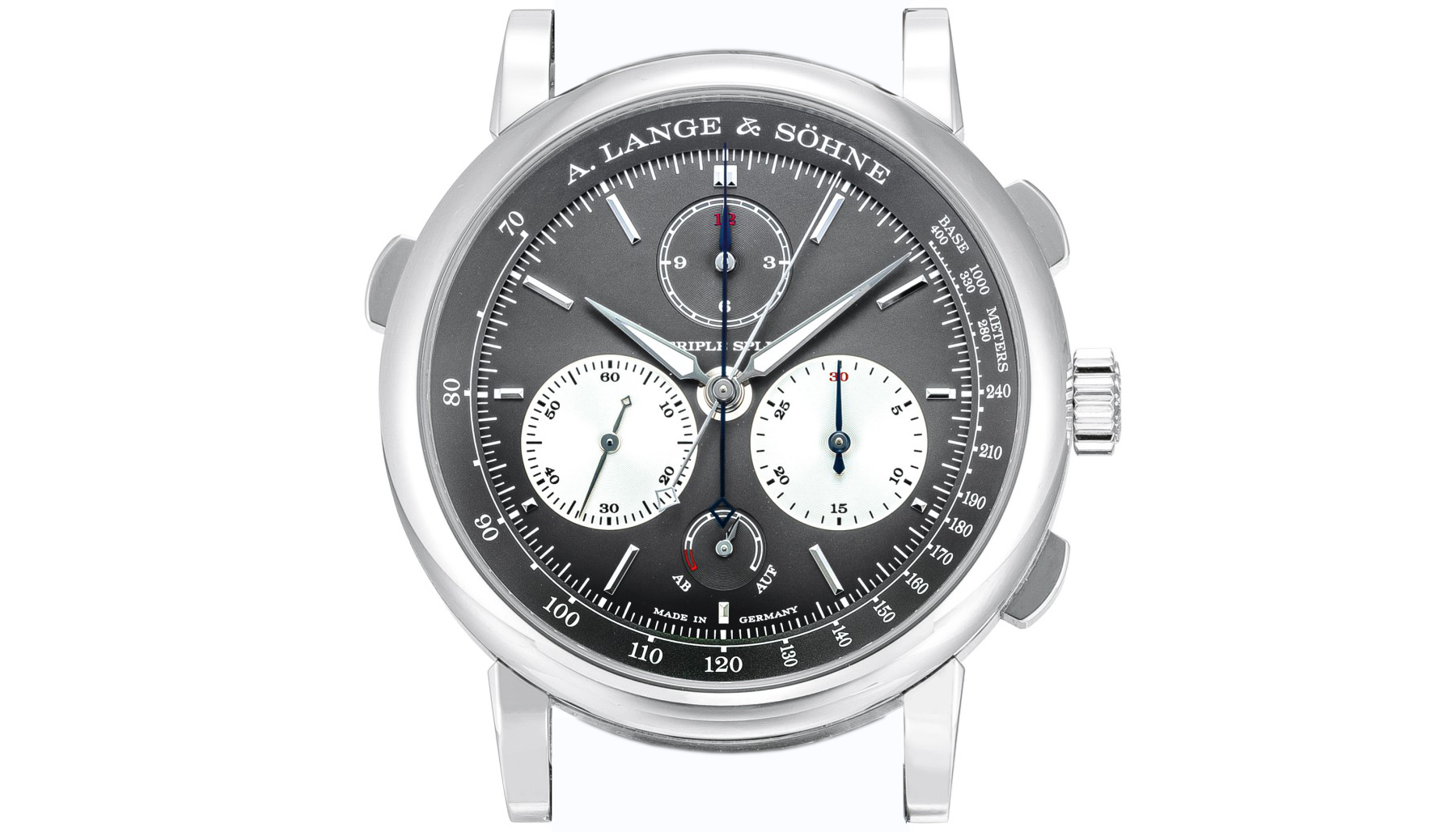
Introduced in 2018 as a new chapter in chronograph wizardry of the manufacture, the Lange Triple Split is paired with a white gold case and has a limitation of 100. Measuring at an assertive and hockey puck(ish) 43.2 mm in diameter and 15.6 mm in thickness, Triple Split indeed reminds us that it is a continuation of the bicep-curl worthy Double Split in platinum. However, simply due to its metal (gold vs platinum) the reference 424.038 wears much better than its hefty patriarch.
As a classic A. Lange & Söhne, the Triple Split’s case is made of three-parts with definite lines and contours. In a way, its aggressive lines accompany its untouchable complication, emphasizing that what you hold / wear is something majestic. As if the Triple Split wants to deliver you that feeling from every possible angle with every touch. It almost feels industrial with its soldered lugs to alternating, polished / brushed / polished case back, case band and bezel; yet not without a soul. I must say, the Triple Split is one of the best watches to carry Lange’s case design.

Thick, but fills it up. Courtesy of WatchBox.
Even though it is based on the Double Split’s caliber L001.1, Triple Split has a re-arranged dial design to accompany its namesake complication; measuring hours at 12 o’clock. To open up space, the power reserve indicator is pulled down to 6 o’clock, right in between the running seconds (9 o’clock) and chronograph / rattrapante minute counter (3 o’clock).
Due to its size, Triple Split is not the most comfortable watch around. Yet, it is somewhat balanced. The lugs’ curve helps the comfort tremendously as it pulls the strap down. However, it is not thicker than anything, too. Simply because there is nothing else to compare. To say that something is thick, one must have a reference point of thinness and Triple Split stands as unique and with the just right size – until someone else comes along and makes it somehow thinner.
With its baton indices and the tachymeter scale at the periphery of the dial, Triple Split surely derives its inspiration from the reference 404.032. Furthermore, it is also very much in line with A. Lange & Söhne’s case material / color pairing > white gold goes with grey.
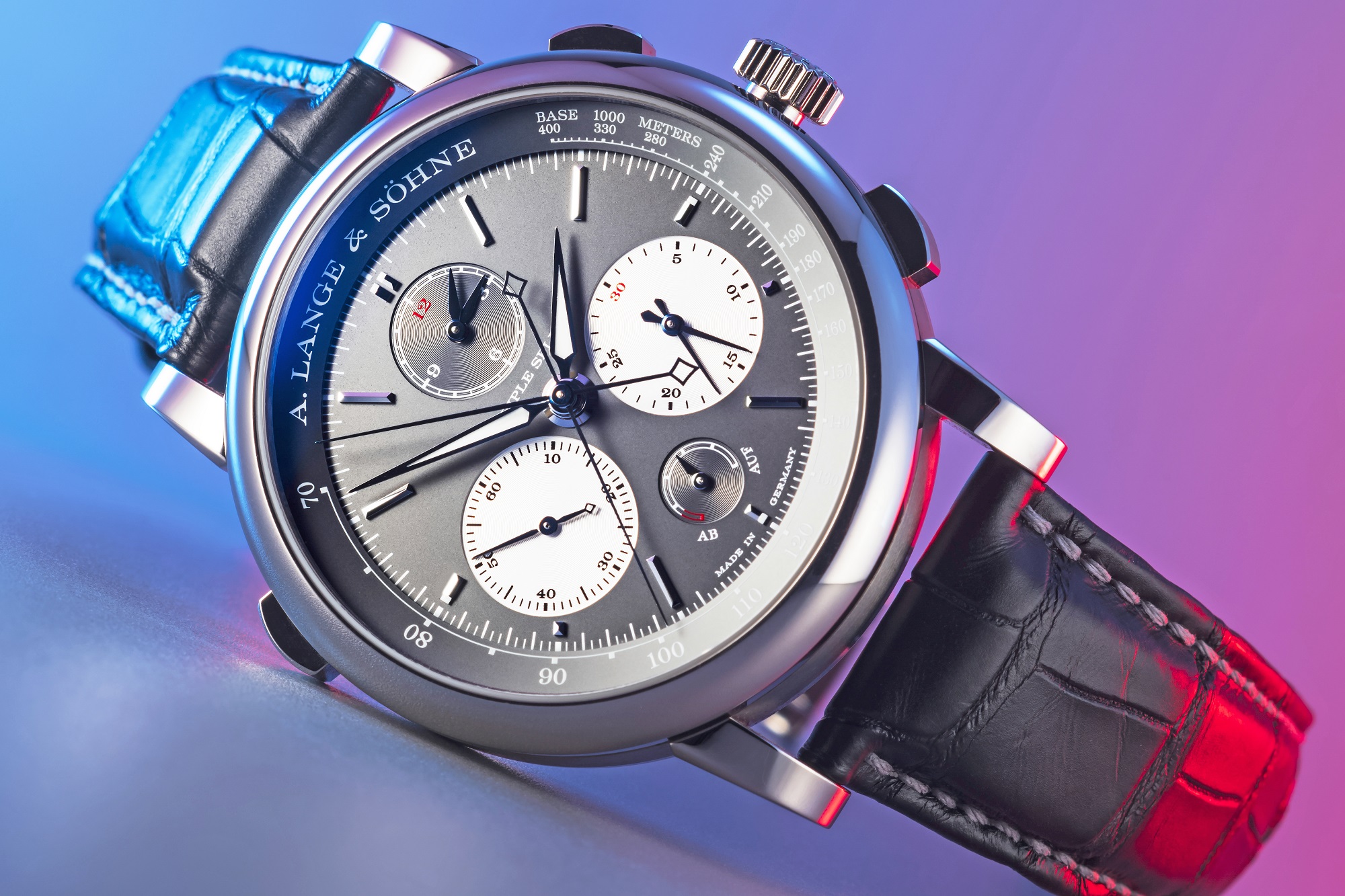
Courtesy of my super talented friend @waitlisted
The detailing on the dial is very nice. The silver based dial has a lovely texture to it. The recessed panda dials are recessed and finished with concentric circles to differentiate the indications from the rest. The use of strong blue along with rhodium hands are just brilliant, further improving the industrial visuality of the piece without breaking the monochrome look, but adding just enough fun to save it from being lifeless.
However, the dial design is not the only novelty the Triple Split offers over its predecessor. It has more on the back, much more than an hour split.
Caliber L132.1
Caliber L132.1 of the Triple Split is a double rattrapante mechanism that is improved upon the existing L001.1 of the Double Split. Its specialty comes from the extra mile it takes. While a standard rattrapante mechanism splits only seconds, Triple Split does not split only seconds and minutes, but also hours. Now, if you know about the Double Split’s groundbreaking improvement over Datograph in 2004, initially, you might have a hard time understanding the importance of the caliber L132.1.
You might perhaps think that the hours addition is a bit more onto the gimmicky side of the innovation scale; which would not be that far from the truth. GaryG_1 says the Triple Split is one split too many and I agree to an extent. But this watch reveals its true innovation when one goes a bit deeper.

Caliber L132.1 of the Triple Split. A Metropolis behind the glass. Courtesy of my super talented friend @waitlisted
Despite the fact that the Triple Split houses an additional indication (hours), thus the gear train for it and the 17 hours of power reserve increase (from 38 to 55), the caliber L132.1 measures just 0.3 mms thicker than its predecessor L001.1. In other words, it is much more efficient and compact. This alone means so much to me than the additional hours indication. Because it shows me that A. Lange & Söhne indeed stays true to their identity and keeps improving even without competition. This deserves an applause.
The caliber L132.1 is nothing but a work of art as one would expect from an A. Lange & Söhne chronograph. Visually, the Triple Split’s back is almost a copy of the Double Split’s L001.1 with an addition of the hours pillar. Between the two caseback views however, my choice definitely would be the Double Split as it is more exposed – thanks to the lack of the hours’ gear train and covering bridge.
Now, let’s be done with aesthetics and let’s get into the nitty gritty of this masterpiece.

Triple Split starts to show what it was made for upon a press to the pusher at 2 o’clock – chronograph starts running. If you’d like you can reset it without stopping it via the flyback pusher at 4 o’clock. When you press the rattrapante pusher, the rattrapante hand stops and the super-imposed chronograph hand continues to run below. Another push to the rattrapante pusher and the blue hand catches up with the chronograph hand; and both runs in synchronously once again.
To complete these back-to-back missions though, tens of gears and levers interact with each other on the case back, showcasing the magic of the Triple Split. This is one of those things that knowing how makes it more enjoyable. First, let’s see how a basic chronograph work and make our way to rattrapante from there:
The brain of a column-wheel chronograph movement is, well, the column-wheel. If you look closer, you are going to see that the clutch lever, zero-reset lever and the operating lever are all connected to it. The chronograph becomes active when the operating parts of the mechanism connects to the running movement. When the user presses the start button, column wheel spins forward and pushes the clutch lever’s tail in between the pillars. With this motion, the clutch lever moves horizontally and meshes with the chronograph wheel. To stop, pressing the button again, the clutch lever sits on the pillar again and disengages from the chronograph mechanism.
The flyback lever works with a similar principle. A heart lever presses against the claw shaped flyback lever, which contacts the heart cam on top of the chronograph seconds’ wheel and the hand on the dial side flies back to zero.
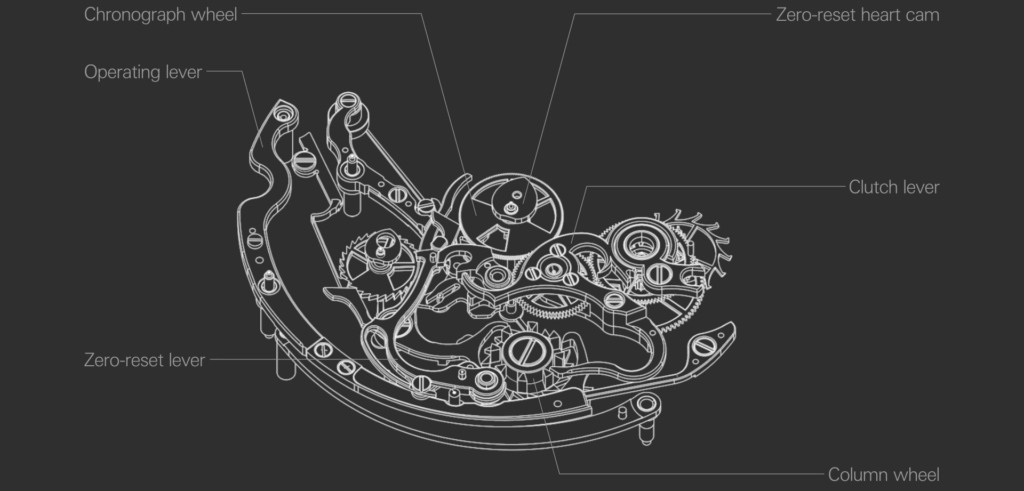
Rattrapante itself is a considerable advancement on chronograph but the Triple Split is truly on another level. To get a better understanding, we must first look at the configuration of the axes for the rattrapante mechanism:
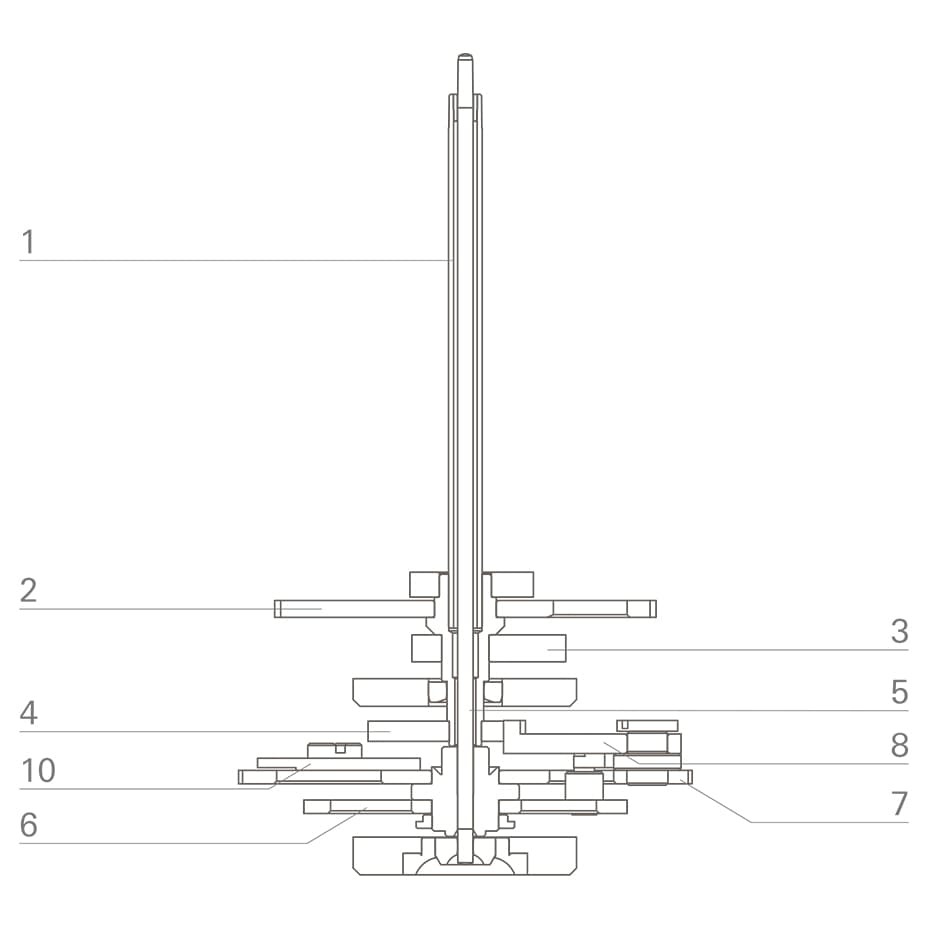
A rattrapante chronograph has two hands seated on arbors that rotate inside each other. In the Triple Split, this arrangement is three-fold: two large seconds hands as well as two small hands each for the minute and hour counters. The following description of the seconds axis applies analogously to the minute and hour counter axes. The chrono sweep-seconds hand is attached to the outer tubular chronograph centre arbor (1). It is driven by the movement via the chronograph wheel (2). It is rigidly connected to the zero-reset heart cam (3) of the chronograph wheel as well as to the rattrapante heart cam (4).
The heart cam makes it possible to reset a hand to zero as quickly as possible, either clockwise or anti clockwise, whichever is faster. The rattrapante hand must also be resynchronised with the chrono sweep-seconds hand after a lap time has been stopped. The rattrapante hand, which is superposed on the chrono sweep-seconds hand, is attached to the inner rattrapante centre arbor (5). At its bottom end, this arbor holds the disengagement wheel (6) and the rattrapante centre wheel (7) to which the freely rotatable rattrapante heart lever (8) is attached.
In the initial state, a spring presses the rattrapante heart lever against the flat side of the rattrapante heart cam, assuring that the rattrapante centre wheel (7) is driven when the rattrapante mode is active. This connects the otherwise separately movable chrono centre arbor (1) and rattrapante centre arbor. When the chronograph is started, all three chronograph and rattrapante hands begin to run at the same time.
Let’s see this on the watch itself:
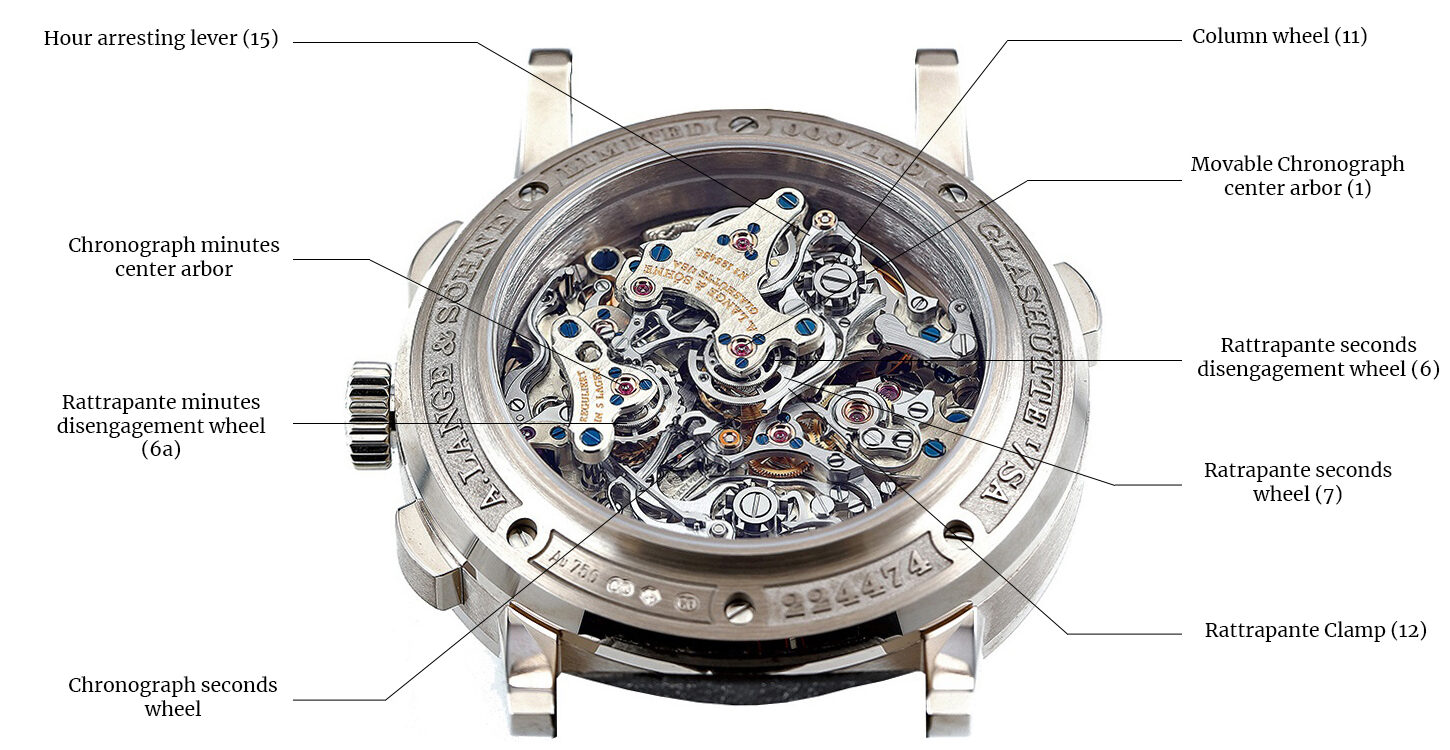
When the rattrapante pusher is actuated, the rattrapante switching lever advances the column wheel (11) by one step. At this point, the rattrapante clamp (12) closes and immobilises the rattrapante centre wheel (7): The rattrapante sweep-seconds hand is now stopped. Concurrently, the minute arresting spring (13) and the hour arresting lever (15) immobilise the rattrapante minute and hour counters. Meanwhile, the three chronograph hands continue to run. When the rattrapante pusher (10) is pressed a second time, the rattrapante clamp (12) opens; the minute arresting spring (13) and the hour arresting lever (15) are pushed aside. The rattrapante hands instantly rejoin the chronograph hands.
Moreover, both the Triple Split and Double Split carries a disengagement mechanism. In conventional rattrapante chronograph designs such as 1815 Rattrapante, as the chronograph runs while the rattrapante is stopped, the heart levers cause friction on the rattrapante heart cams; which decreases amplitude. Disengagement mechanism, via 6 and 6a levers lift the heart levers upon the rattrapante activation, hence prevents the possible friction.

Inimitable depth, showcasing the minute counter (to the left), chronograph and rattrapante wheels (middle), and rattrapante clamps. Courtesy of Lange Uhren GmbH
As a final note; while the minute counter hands jump, the hour hands creep.
The sheer depth of the movement matches the mind-blowing complexity of the caliber L132.1. Carrying 556 stunningly finished parts layer over layer, Triple Split movement beats at 3Hz and offers 55 hours of power reserve. Caliber L132.1 is one of the most impressive things I have ever seen in watchmaking. One just wishes to shrink and wander within this metropol behind the sapphire glass.
The Verdict
If you are not built like Arnold Schwarzenegger or Sylvester Stallone, Triple Split is not an easy to watch to fit on the wrist. It is heavy, thick, and to be honest more like a table-clock. Hence one must ask the question: Are all watches there to be worn at all times? I’d say no, they’re there to be enjoyed and for this dimension Triple Split offers nothing but uniqueness.
From its complication to dial design to movement depth and finish, Triple Split is one of a kind masterpiece that one would cherish and enjoy just by knowing that it is there or simply when you fly from Australia to US with a stop in Dubai and you start your Triple Split from the start, then compare the two legs of your flight. It is this uniqueness both in appearance and application that makes Triple Split worth owning – and possibly pay over retail.
Thank you.
I’d like to thank to my friend Paul (@alangejourney on Instagram) for providing his exquisite Triple Split and James (@waitlisted on Instagram) for sharing his unparalelled macro shots for the creation of this article.
I hope this was a valuable guide for whomever is looking for a Triple Split or just want to learn the details and history of these pieces. If you’d like to chat, sell or buy a Triple Split, please kindly reach out to me via [email protected]
Please feel free to contact:
Follow Langepedia on Instagram:
Watch “A. Lange Story” Documentary, in partnership with WatchBox:
FAMILIES / COMPLICATIONS
STAY IN TOUCH
Sign up for the newsletter to get to know first about rare pieces at Marketplace and in-depth articles added to the encyclopedia, for you to make the most informed choice, and first access!